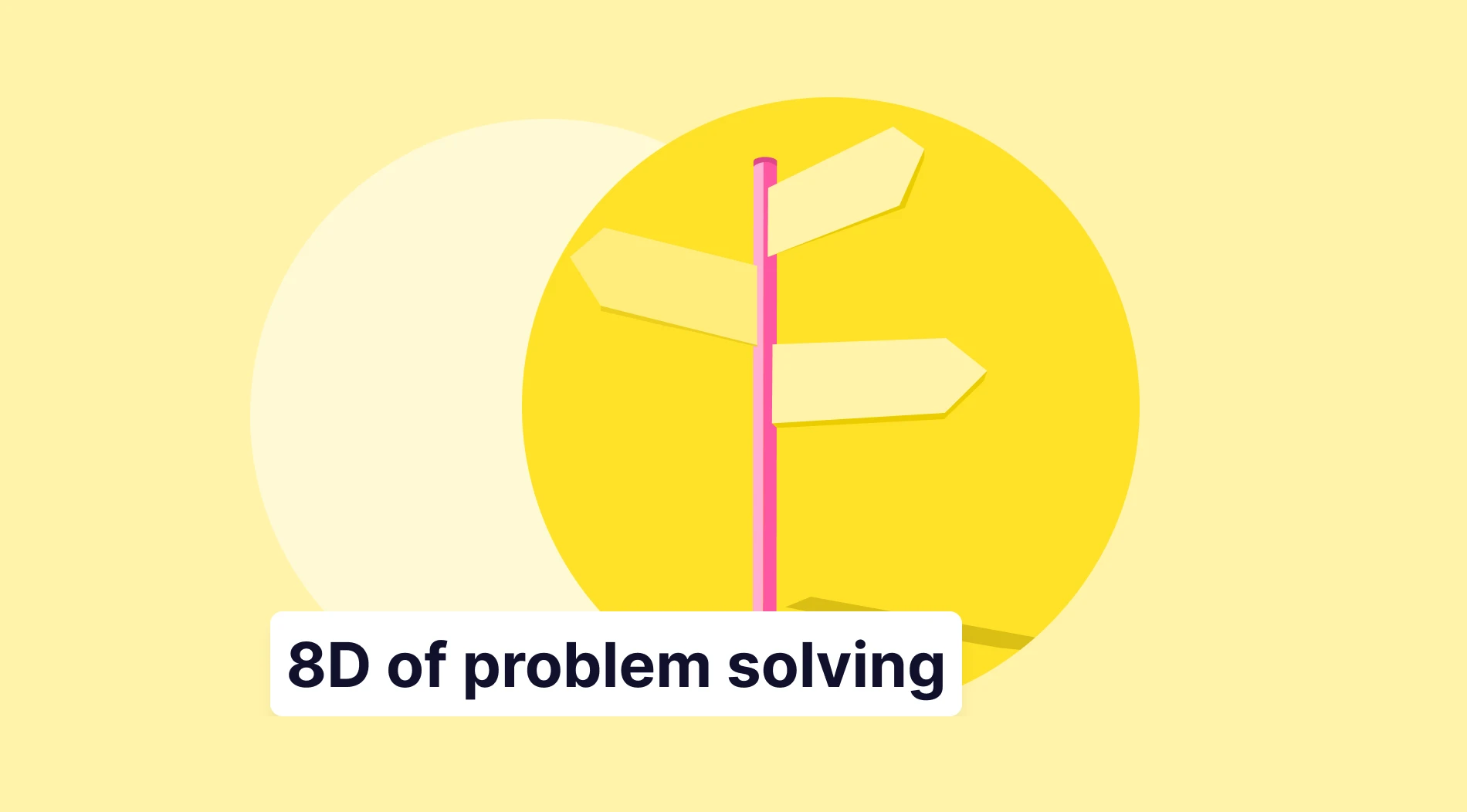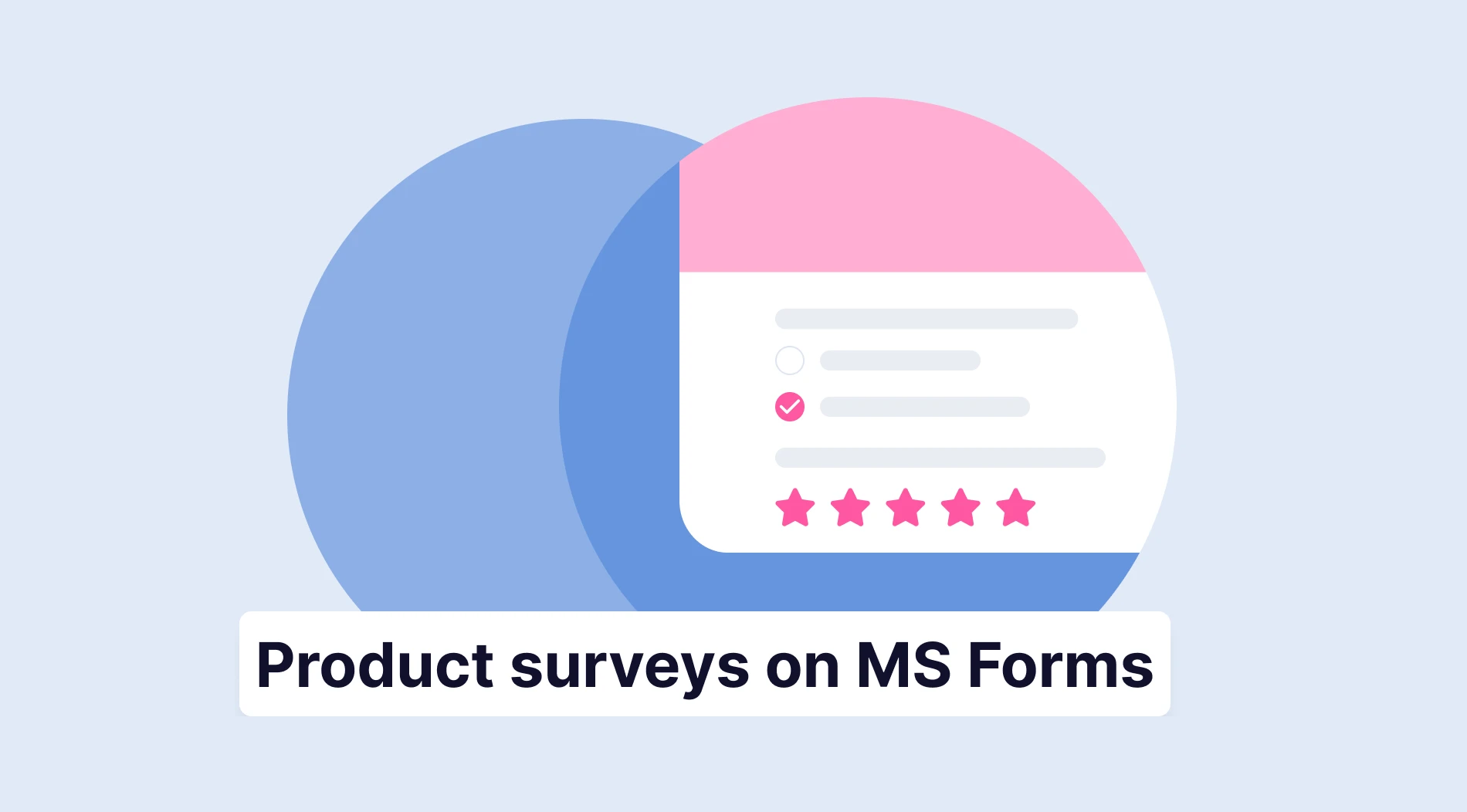In the business world, problem-solving tools have become vital. They help your company tackle complex issues accurately. Following a structured approach, your business can address root causes, prevent recurrences, and improve processes. This boosts operational efficiency and fosters a culture of continuous improvement. Your company can improve product or process quality and increase customer satisfaction.
Today, you’ll learn one of these tools, the Eight Disciplines of Problem Solving (8D). This method will help you solve problems by effectively addressing the root cause. We’ll dive into its components, when to use it, and how well-known establishments use it. Lastly, we will discuss the pros and cons of the model and answer some frequently asked questions.
What is 8D?
The eight disciplines of problem-solving (8D) is a systematic, team-oriented method designed to address and eliminate problems in a business environment.
Developed by Ford Motor Company, this approach focuses on finding the root cause of a problem and implementing long-term solutions to prevent future occurrences. Businesses widely use it in manufacturing, engineering, and other industries where quality is critical.
Using 8D, your company can tackle issues in a structured way, improving processes and reducing the repetition of problems. This method is particularly effective for addressing complex or chronic issues that require in-depth analysis. The aim is not only to resolve the immediate issue but also to prevent it from happening again. It is an approach that fosters a proactive culture of problem-solving.
8D: Explained
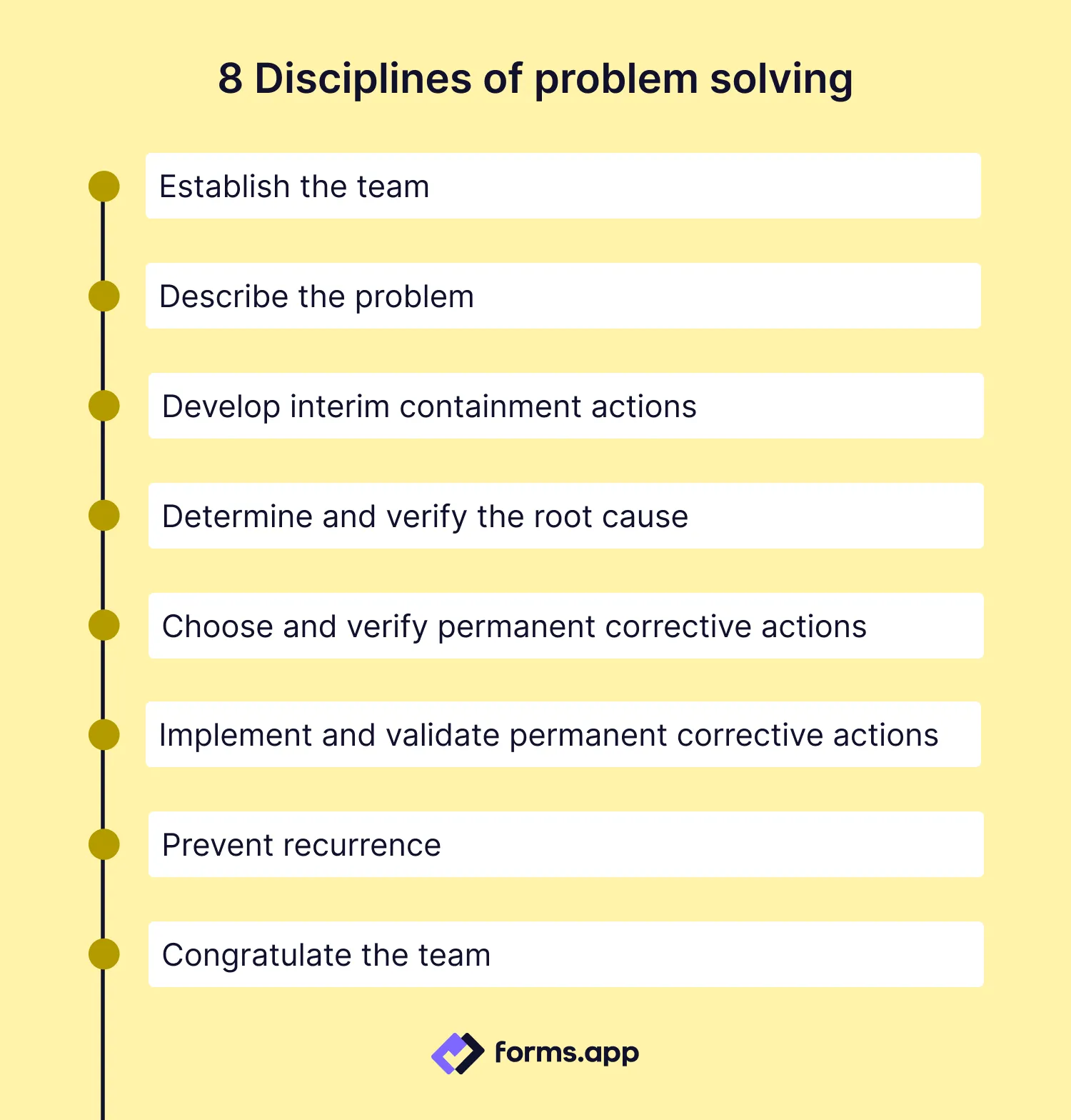
8D of problem solving
We have familiarized ourselves with the concept of 8D (eight disciplines of problem-solving). In this section, we will dive into the model and explore all its components. Here are the eight disciplines of problem-solving that will greatly help you enhance your business processes:
D1: Establish the team
The first step in 8D is to assemble a team of individuals with the knowledge and skills to address the problem. This team should have multiple functions. This means the committee should include members from different departments or areas of expertise to provide a comprehensive view of the issue. The team leader is usually someone with experience in problem-solving methods.
Collaboration is key in this phase because the complexity of most problems requires input from various perspectives. You need to establish a capable team. This way, you can ensure that your company approaches the issue with a diverse range of insights and solutions.
D2: Describe the problem
In the second step, the team defines the problem in detail (problem statement). This includes describing its symptoms, scope, and impact on the business. The goal is to clarify what is wrong so your team can focus its efforts on solving it. It is essential to be specific, as vague problem descriptions can lead to ineffective solutions.
By using data and facts, your team can create a clear picture of the problem, which helps identify the root cause later. A well-defined problem sets the stage for successful analysis and resolution. It makes this step essential in the 8D process. Remember, describing the problem is halfway to solving a problem.
D3: Develop interim containment actions (ICA)
Once you define the problem, your team must implement temporary measures to contain its effects. These actions prevent the problem from worsening while you develop a permanent solution. Interim containment actions are crucial because they buy you time for a thorough investigation without letting the problem disrupt your business operations.
These actions are not the final fix but are necessary to keep things under control. Your team must ensure these measures are effective and do not introduce new issues. This maintains business continuity during the problem-solving process.
D4: Determine and verify the root cause
Step four of the 8D model involves identifying the root cause of the problem. Here, your team uses various tools and techniques, such as the 5 Whys or Fishbone diagram, to dig deeper into the issue and find the origin. Once you identify the root cause, you must verify it through data or testing.
Verification is vital to ensure your team has identified the actual cause, not just a symptom. By addressing the root cause, your team can create long-lasting solutions. It reduces the likelihood of the problem recurring. Accurate identification and certification are critical to the success of 8D.
D5: Choose and verify permanent corrective actions (PCA)
After identifying the root cause, your team develops permanent corrective actions to solve the problem. These solutions must be effective and sustainable. Once you identify the potential solutions, your team must test and verify them to ensure they truly eliminate the problem without causing unintended side effects.
Verification often involves testing the solutions in a controlled environment before full implementation. This step ensures that the corrective actions address the root cause and are viable in real-world applications. Effective permanent corrective actions are crucial for your business’s long-term success.
D6: Implement and validate permanent corrective actions (PCA)
In the sixth step, your team implements the verified corrective actions across all relevant areas of the business. Validation is the key here, confirming that your solution works as intended in real-world conditions. The team monitors the results to ensure that you have fully resolved the problem and that no new issues have arisen.
Proper implementation and validation are vital for making sure the problem does not occur again. This phase often involves training employees, updating procedures, and communicating the changes throughout the organization to ensure smooth execution.
D7: Prevent recurrence
Once you have validated the corrective actions, the focus shifts to preventing the problem from happening again. This involves updating company policies, procedures, or training programs to reflect the changes made. Your team may also recommend additional preventive measures based on lessons learned during the 8D process.
By embedding these changes into your company’s daily operations, you can create a culture of continuous improvement. Preventing recurrence is essential for maintaining long-term success and avoiding the same issues in the future.
D8: Congratulate the team
The final step in the 8D process is to recognize your team’s efforts. Celebrating success boosts morale and encourages employees to engage in future problem-solving initiatives. Acknowledging the hard work and collaboration that went into solving the problem is important. It fosters a positive and proactive work environment.
It also serves as a reminder of the importance of teamwork and structured problem-solving. This step helps close the loop on the process, reinforcing the value of 8D methodology and encouraging its continued use in your company.
When to use the 8D
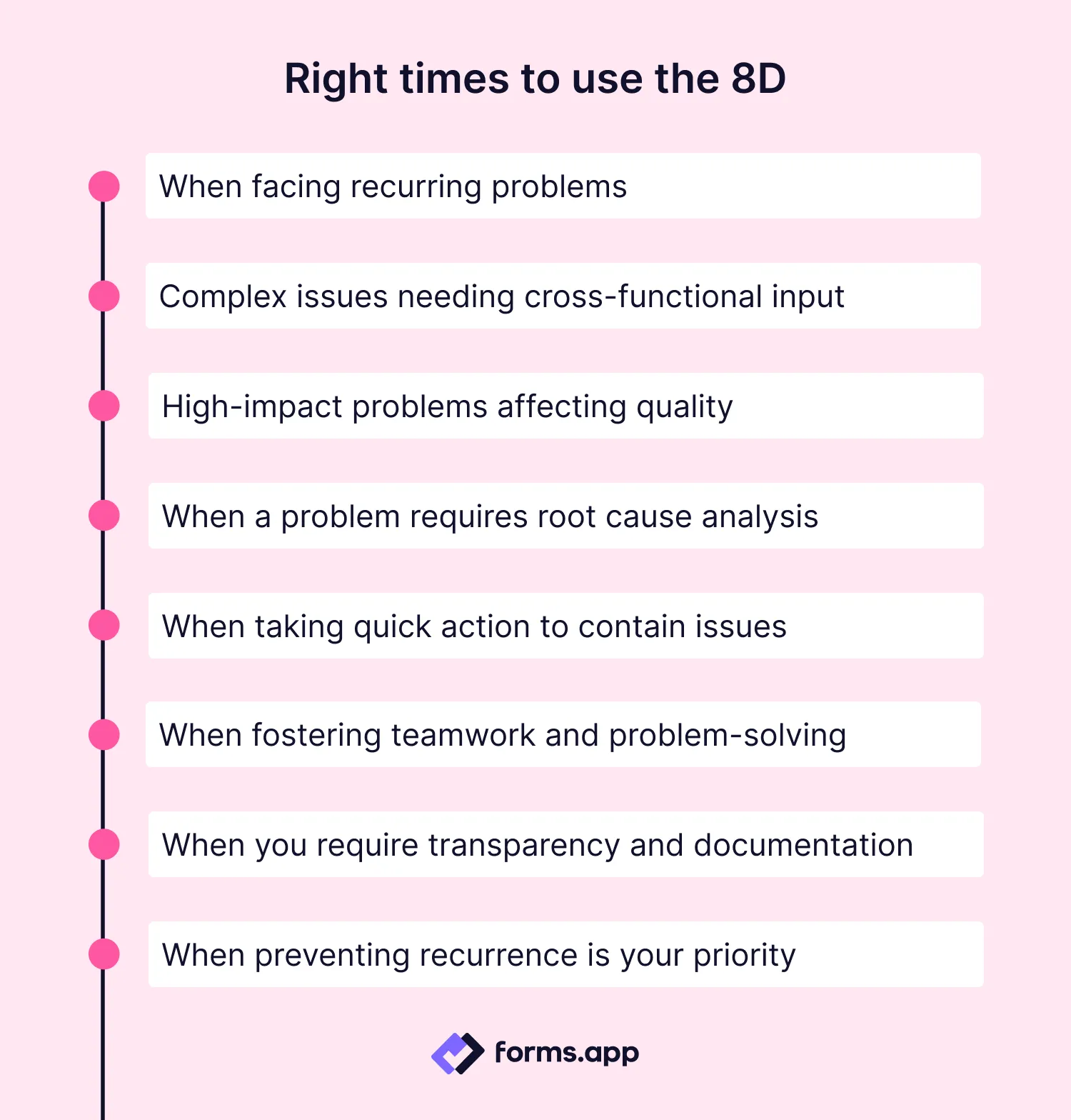
Correct times to use the 8D
We have seen all eight disciplines of problem-solving (8D). Now, we will look at the suitable environments or contexts for using this model. This section may be particularly important as one of the categories might be the exact issue that you are facing in your business.
1- When facing recurring problems
The 8D method is highly effective when a business faces recurring issues that haven’t been solved through regular troubleshooting. These problems often indicate deeper root causes needing thorough analysis. If you apply 8D, your teams can dig into the issue, uncover the underlying cause, and develop a permanent solution. This helps you solve the immediate problem and prevents it from reappearing.
2- Complex issues needing cross-functional input
Some problems require input from various departments or expertise areas. When a challenge is complex and touches multiple facets of the business, 8D is an ideal tool. Its cross-functional team approach ensures that you consider all perspectives. This allows your company to address the problem in a holistic manner. Your business will also be able to find more effective solutions to complex issues.
3- High-impact problems affecting quality
In industries where quality is crucial, businesses often use 8D to address high-impact problems that could lead to product defects or customer dissatisfaction. This is especially true in manufacturing, where defects can be costly or cause recalls. 8D provides a framework for identifying and resolving quality issues quickly and efficiently. By using it, you can ensure that your products/services have the highest standards.
4- When a problem requires root cause analysis
The 8D method is specifically for finding the root cause of a problem. When your business encounters an issue that seems to be a symptom of a larger problem, 8D is the go-to approach. It goes beyond surface-level fixes to dig deeper into the issue. This, in turn, ensures that your solution addresses the real cause.
5- When you need interim actions to contain the problem
In situations where a problem has immediate negative consequences, interim containment actions are necessary to prevent the issue from worsening. The 8D method includes a step to implement temporary measures to keep the problem under control. This buys you time when you are developing a permanent solution. It makes it particularly useful in urgent situations where stopping the spread of the issue is critical.
6- When improving team collaboration and problem-solving culture
8D is not just an efficient problem-solving tool. It also fosters a culture of collaboration and continuous improvement. Involving cross-functional teams in the process encourages knowledge-sharing and collective problem-solving. This can lead to long-term benefits beyond solving similar problems. Your employees learn to work together more effectively and apply structured problem-solving methods to future challenges.
7- When you require transparency and documentation
For industries requiring thorough documentation and transparency, such as automotive or aerospace, 8D is invaluable. The process involves documenting every step, from problem identification to corrective actions. This provides a clear record of how you address the issue. A level of transparency is often necessary for compliance, audits, and customer assurance. It makes 8D a sustainable solution for your business.
8- When preventing recurrence is your priority
The ultimate goal of 8D is to prevent problems from recurring. If your business faces issues that seem to recur over time, 8D can help identify and address the root cause. By embedding preventive actions into your company procedures, you can ensure long-term success. The focus on recurrence prevention is what makes 8D a sustainable solution for your business.
Examples of the 8D
We have explored some suitable environments and contexts for the use of the eight disciplines of problem-solving. In this section, we will explore how some of the most well-known countries utilize this model and achieve positive results. These 8D examples can also be an influence for your business:
1- Ford Motor Company
Ford is the creator of the 8D method and extensively uses it in its operations. One famous example is when Ford applied 8D to resolve quality issues in its vehicles. By forming cross-functional teams and following the 8D steps, they identified the root cause of several recurring defects and implemented corrective actions.
This led to significant improvements in the quality of their cars and reduced the number of customer complaints. Ford’s continued use of 8D shows its effectiveness in large, complex manufacturing environments where quality and customer satisfaction are paramount.
2- General Motors (GM)
General Motors (GM) has used the 8D method to address supply chain issues that were affecting production timelines. By applying 8D, GM identified the root cause of delays and developed solutions that improved their supplier management processes.
The team involved representatives from purchasing, production, and logistics. This ensured a comprehensive view of the problem. GM’s use of 8D helped streamline its supply chain and ensure that production could continue without disruption. This demonstrates how you can apply the method to a range of business problems beyond just product quality.
3- Boeing
Boeing has used the 8D model to resolve issues in its aircraft manufacturing processes. One notable instance was when they faced recurring problems with a component in their planes. By applying 8D, they were able to identify the root cause, which was an issue in the supplier’s manufacturing process. They worked with the supplier to implement corrective actions.
This not only solved the immediate issue but also strengthened their supply chain by improving supplier quality. Boeing’s success with 8D shows how you can use the method in highly regulated industries where safety and precision are critical.
Benefits and pitfalls of using 8D
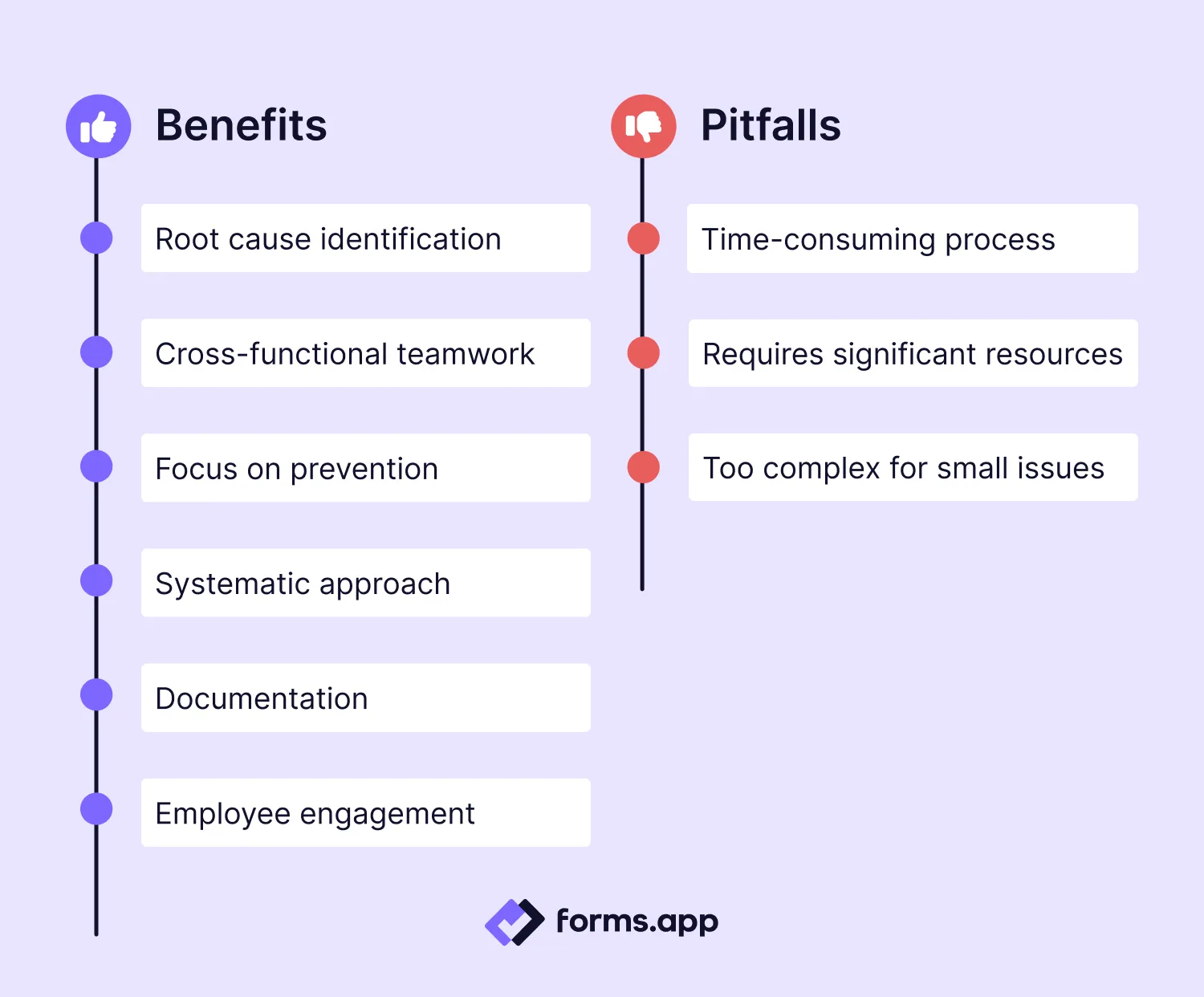
Advantages and disadvantages of using 8D
Now, you have learned that 8D is a versatile problem-solving tool that you can use in various contexts and environments. Although we have briefly touched upon the benefits of the model, we will examine the benefits and pitfalls of using an 8D tool in your business. Here are some of the pros and cons:
Benefits
👍🏻 Root cause identification: One of the main advantages of the 8D method is its focus on identifying the root cause of a problem. This prevents companies from applying temporary fixes that don't address the underlying issue. By tackling the problem at its source, businesses can implement long-lasting solutions, saving time and resources.
👍🏻 Cross-functional teamwork: The 8D method encourages collaboration across different departments, fostering a culture of teamwork. By bringing together experts from various fields, the company gains a holistic view of the problem, ensuring that no aspect is overlooked.
👍🏻 Focus on prevention: Unlike other problem-solving methods that focus on resolving the immediate issue, 8D emphasizes preventing the problem from recurring. This proactive approach helps businesses avoid future disruptions and ensures that improvements are sustainable.
👍🏻 Systematic approach: The structured nature of the 8D method ensures that problems are addressed methodically, leaving little room for guesswork or oversight. Each discipline builds upon the previous one, creating a logical progression from problem identification to solution implementation.
👍🏻 Documentation and transparency: The 8D process requires thorough documentation of every step, from problem definition to corrective actions. This creates a clear record of how the issue was addressed, providing transparency and accountability.
👍🏻 Employee engagement: The collaborative nature of 8D encourages employee participation and engagement in problem-solving efforts. By involving team members from different departments, the method promotes a sense of ownership and responsibility for finding solutions.
Pitfalls
👎🏻 Time-consuming process: One potential drawback of the 8D method is that it can be time-consuming. The structured approach requires teams to follow each discipline carefully, which can slow down the process, especially for urgent issues.
👎🏻 Requires significant resources: The 8D method requires assembling a cross-functional team, which can strain resources, especially in smaller organizations. The process also demands time and effort from employees who may already have other responsibilities.
👎🏻 May be too complex for minor problems: While 8D is highly effective for complex and recurring problems, it may not be the best approach for smaller, less critical issues. The level of detail and structure required can make it an inefficient tool for problems that could be solved more quickly through simpler methods.
Frequently asked questions about 8D
Last but not least, let’s answer some of the most frequently asked questions about the eight disciplines of problem-solving (8D). Understanding these answers will help you get a better comprehension of the subject and use the model more effectively in your business.
An 8D problem-solving template checklist is a tool used to guide teams through the Eight Disciplines of Problem Solving process. It outlines each step, from assembling the team to implementing corrective actions, ensuring nothing is overlooked.
The checklist helps maintain consistency and thoroughness in problem-solving efforts. It’s a valuable resource for businesses that want to standardize their approach to solving recurring or complex problems.
An 8D report example provides a real-world case of how the 8D method was applied to solve a specific problem. It includes all process steps, including problem definition, root cause analysis, and corrective actions.
By reviewing examples, teams can gain insights into how to apply 8D to their own challenges. Examples also help illustrate the practical benefits of using the method, such as preventing problem recurrence.
The time it takes to complete an 8D problem-solving process varies depending on the complexity of the problem. For minor issues, it might take just a few days to work through all the steps. However, for more complex problems, especially those requiring extensive root cause analysis or testing of solutions, the process could take weeks.
The purpose of the 8D discipline problem solving is to provide a structured approach to solving problems by identifying the root cause and implementing long-term solutions. It aims to prevent recurring issues by addressing the underlying factors rather than just the symptoms.
The 8D process also promotes teamwork and documentation, helping organizations improve their problem-solving culture and maintain high standards of quality and efficiency.
Root cause analysis is a critical part of the 8D problem-solving methodology. It involves investigating the underlying factors that led to the problem rather than just addressing its surface symptoms.
Using tools such as the 5 Whys or fishbone diagrams, teams can trace the problem back to its origin. Once the root cause is identified, the team can develop corrective actions that prevent the issue from recurring.
Conclusion
The eight disciplines of problem-solving (8D) is a powerful method for addressing complex and recurring problems. Its structured approach, emphasis on root cause analysis, and focus on prevention make it ideal for businesses that want to improve their processes and avoid future disruptions. By involving cross-functional teams, 8D encourages collaboration and fosters a culture of continuous improvement.
In this comprehensive guide, we have examined all of the components of 8D, seen when to use it, and why it is effective. We have also explored real-life examples from well-known companies and showed the practical benefits and some pitfalls of the method. If your business faces complex challenges, start applying the 8D method to resolve the issues now!
Fatih is a content writer at forms.app and a translator specializing in many text domains, including medical, legal, and technical. He loves studying foreign languages. Fatih especially likes to create content about program management, organizational models, and planning tools.
